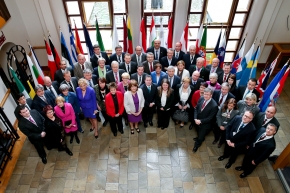 Gallery
Gallery
The European Youth Guarantee is more than just a significant tool for curbing unemployment; it is also an opportunity to significantly reduce migration caused by the high level of youth unemployment, said Arvils Ašeradens, Deputy Chairman of the Social and Employment Matters Committee, at a meeting of chairpersons of employment, enterprise, innovation and social affairs committees of the national parliaments of the European Union held in Dublin on Monday, 29 April.
László Andor, EU Commissioner for Employment, Social Affairs and Inclusion, supported this idea and expressed his desire to learn more about the employment situation in Latvia, something he intends to do during his visit to Latvia and meetings with MPs in June.
The European Youth Guarantee is a European Commission’s initiative which provides young people from 15 to 24 years of age with job offers, studies or practical training within four months of registering with the unemployment service.
In developing the framework for implementing this initiative, more emphasis must be placed on simplifying monitoring procedures. For the plan to be realistic and efficient, all stakeholders - Commission services, EU member states and the youths - have to make their contribution, said Ašeradens in his address to colleagues.
When characterising the unemployment situation in Latvia, the Deputy Chairman indicated that the main problem is young people who are neither employed nor in education or training. Therefore, we are focusing our efforts on low-skilled youths under 25 years of age and on opportunities to return them to the education system.
As a result of youth-oriented labour market policy measures, during a two-year period Latvia has managed to reduce the youth unemployment rate from a peak of 42% in 2010 to 28.4% in 2012, said Ašeradens. He expressed hope that the data on 2013 will also show a significant decrease in the level of unemployment among this age group and thus will drop below the average EU level.
Information provided by the Ministry of Welfare indicates that in January 2013, the average youth unemployment rate in the EU was 23%, with 9% in Germany and Austria, and 55% in Greece and Spain.
Discussion on the situation of young people and proposed policy measures should also take into account all potential obstacles thwarting access to good-quality jobs, education or training. Positive results can be expected only through the involvement of all relevant stakeholders, indicated the MP as he urged social partners and youth organisations to engage in the process.
Even though there are no immediate solutions to the unemployment problem, the overall situation is improving steadily together with the growth and improvement of the macroeconomic situation. Nevertheless, it is essential to activate the workforce by inter alia ensuring training in professions with a high potential of employment, indicated Ašeradens.
Youth unemployment creates risks of social exclusion and causes other negative consequences for young people and the entire European society. According to the data provided by the European Foundation for the Improvement of Living and Working Conditions, in 2011 relevant losses in the EU amounted to EUR 153 billion, or 1.2% of the EU’s GDP.
On Monday, 29 April, Arvils Ašeradens, Deputy Chairman of the Social and Employment Matters Committee, attended a meeting of chairpersons of employment, enterprise, innovation and social affairs committees of the national parliaments of the European Union held in Dublin (Ireland). The main topics addressed during the meeting included youth unemployment as a challenge for the European Union, harnessing the potential of European SMEs, and fostering an entrepreneurial Europe through innovation.
Saeima Press Service







